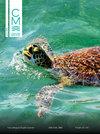一种海洋岩石池栖动物虎的分类学和分子多样性研究
IF 0.7
4区 生物学
Q4 MARINE & FRESHWATER BIOLOGY
引用次数: 8
摘要
1869年,Tigriopus Norman的西班牙桡足类属分布在世界各地的沿海岩石池塘中,目前被认为包括14个有效物种。Tigriopus fulvus(Fischer 1860),及其亚种Tigriopus fulvus Adriaticus van Douwe 1913和Tigriopus fulvus Algiricus Monard 1935,以及Tigriopus Minutus Bozic 1960已被描述为地中海地区,但该属的真正多样性目前尚不清楚。这项研究的目的是评估地中海虎种群的真实身份,并阐明它们的分类和遗传多样性模式。为此,将线粒体DNA基因(细胞色素C氧化酶I亚基)的一段片段作为参考标记。结果表明,在整个研究领域,存在一个以遗传结构为特征的物种,具有显著的地理基础。这里观察到的多样性模式暂时归因于第一批到达岩石海岸的移民对岩石海岸池塘的强烈垄断。然而,这种垄断定期被局部灭绝事件打断,这些事件在本质上不稳定的岩池栖息地中很常见。在这里,我们为这种模式提出了“周期性垄断”的名称。1869年的Tigriopus Norman桡足类属分布在世界各地的海岸岩池中,目前被认为包括14个有效物种。Tigriopus fulvus(Fischer 1860),其亚种Tigriopus fulvus Adriaticus van Douwe 1913和Tigriopus fulvus Algiricus Monard 1935,以及Tigriopus Minutus Bozic 1960目前据报发生在地中海地区,但该属的实际多样性目前尚不清楚。我们的目的是评估地中海虎种群的实际身份,并阐明它们的分类和遗传多样性模式。为了实现这些目标,对线粒体DNA基因(细胞色素C氧化酶亚单位I,IOC)的一段片段进行了测序,以用作参考标记。我们的数据表明,整个研究领域存在一个以值得注意的地理遗传结构为特征的单一物种。在这里,观察到的多样性模式暂时被第一批到达它们的移民描述为对岩石池的强烈垄断。然而,这种垄断定期受到当地灭绝事件的破坏,这些事件在本质上不稳定的岩池栖息地中很常见。我们为这种模式提出了“时钟工作垄断”的名称。本文章由计算机程序翻译,如有差异,请以英文原文为准。
An account on the taxonomy and molecular diversity of a marine rock-pool dweller, Tigriopus fulvus (Copepoda, Harpacticoida)
espanolEl genero de copepodos Tigriopus Norman, 1869 se distribuye en todo el mundo en charcas de rocas costeras y se considera que actualmente incluye 14 especies validas. Tigriopus fulvus (Fischer 1860), con sus subespecies Tigriopus fulvus adriaticus Van Douwe 1913 y Tigriopus fulvus algiricus Monard 1935, y Tigriopus minutus Bozic 1960 han sido descritos para el area del Mediterraneo, pero la diversidad real del genero es desconocida actualmente. El objetivo de este estudio fue evaluar la identidad real de las poblaciones mediterraneas de Tigriopus y dilucidar su taxonomia y patron de diversidad genetica. Con este fin, se secuencio un fragmento del gen de ADN mitocondrial (citocromo c oxidasa subunidad I, COI) como marcador de referencia. Los resultados sugieren la presencia de una sola especie caracterizada por una estructuracion genetica con una notable base geografica en toda el area de estudio. El patron de diversidad observado aqui se atribuye tentativamente a una fuerte monopolizacion de las charcas de las costas rocosas por parte de los primeros inmigrantes que las alcanzan. Sin embargo, tal monopolizacion se interrumpe periodicamente por los eventos de extincion local, los cuales son frecuentes en los habitats de charcas de rocas que son intrinsecamente inestables. Aqui proponemos para este patron el nombre de “monopolizacion periodica” (“clockwork monopolization”). EnglishThe copepod genus Tigriopus Norman, 1869 is distributed worldwide in coastal rock pools and it is currently considered to include 14 valid species. Tigriopus fulvus (Fischer 1860), with its subspecies Tigriopus fulvus adriaticus Van Douwe 1913 and Tigriopus fulvus algiricus Monard 1935, and Tigriopus minutus Bozic 1960 are currently reported to occur in the Mediterranean area, but the actual diversity of the genus is currently unknown. We aimed to assess the actual identity of Mediterranean Tigriopus populations and to elucidate their taxonomy and pattern of genetic diversity. In order to reach these goals, a fragment of a mitochondrial DNA gene (cytochrome c oxidase subunit I, COI) was sequenced to be used as a reference marker. Our data suggest the presence of a single species characterized by a noteworthy geographically based genetic structure in the whole study area. The observed diversity pattern is tentatively ascribed here to a strong monopolization of the rock pools by the first immigrants that reached them. However, such a monopolization is periodically disrupted by local extinction events, which are frequent in the intrinsically unstable rock pool habitats. We propose the name “clockwork monopolization” for this pattern.
求助全文
通过发布文献求助,成功后即可免费获取论文全文。
去求助
来源期刊

Ciencias Marinas
生物-海洋与淡水生物学
CiteScore
1.10
自引率
0.00%
发文量
9
审稿时长
>12 weeks
期刊介绍:
A bilingual open-access publication, Ciencias Marinas (CM) is an international peer-reviewed journal that contains original research findings in all areas of marine science. It is published quarterly by the Autonomous University of Baja California, Mexico, and all its contents are publicly available on our journal website. Though a limited number of copies are still printed, the journal is mainly distributed in its electronic format.
CM was conceived in 1973 as part of an academic project aimed to entice local researchers to publicly disclose their findings by adopting the culture of peer-review publishing. This academic project evolved into an international journal after accepting papers from researchers in the United States and, eventually, other parts of the world. Because of the diversity in authorship, CM issues were initially published in either Spanish or English, and occasionally in both languages. It was not until 1984 when CM included both language versions of all its contents, and it then became the fully bilingual journal it still is today. At CM we believe our inclusive format allows us not only to address a wider range of submissions from international authors but also to make published findings available to a wider international audience.
So whether you are looking for information on the redfish in Icelandic waters or the physical and biological properties of the Gulf of California, feel free to peruse CM contents. You may find them to provide source material for your research.
 求助内容:
求助内容: 应助结果提醒方式:
应助结果提醒方式:


